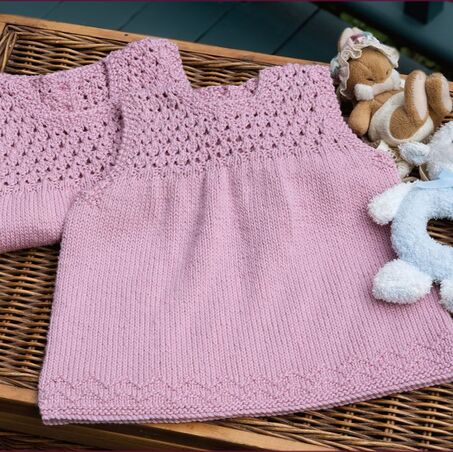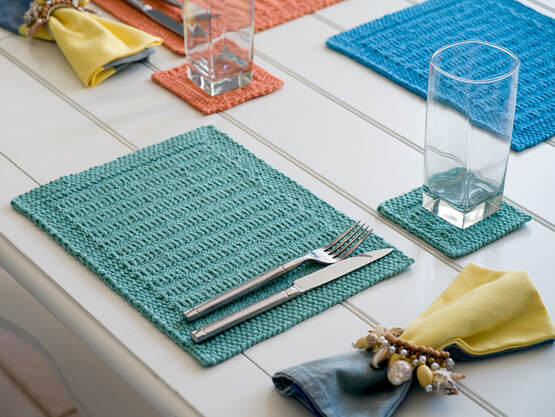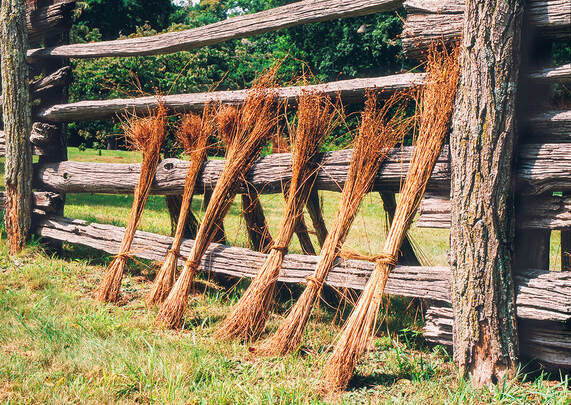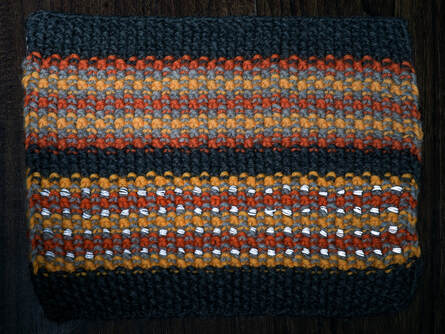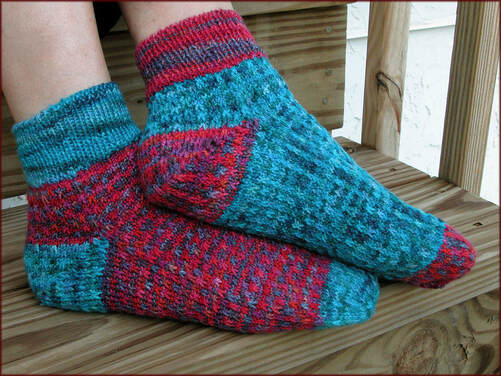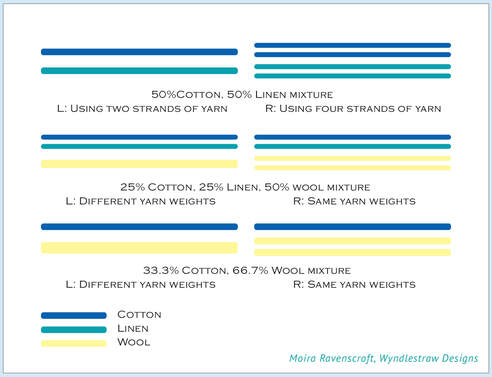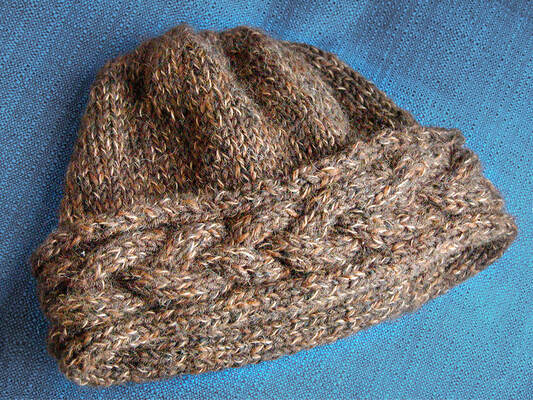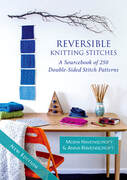Last week I had the fun of knitting a new Aelwen Baby Dress for a friend’s daughter who is expecting a little girl in the summer. So I dug through my yarn stash and found a good quantity of the yarn I needed to knit a new dress. I do love summer pinafore dresses for baby girls and this one has such a delightful drape and flow because the yarn is not just cotton but a cotton/rayon mix.
That combination illustrates just how different fibres mixed together can bring out the best qualities of each of them. Here the cotton base layer has provided strength and structure while the rayon has give a cool fluidity and sheen. It is a lovely fibre mix and just shows what can be achieved either by finding the perfect yarn or by using two or more thinner yarns at the same time.
So in today’s blogpost in the “Seeing Double” series I am going to look at some possibilities for combining fibres to add texture, drape, strength, visibility and other attributes to your next project.
Getting Ideas:
That combination illustrates just how different fibres mixed together can bring out the best qualities of each of them. Here the cotton base layer has provided strength and structure while the rayon has give a cool fluidity and sheen. It is a lovely fibre mix and just shows what can be achieved either by finding the perfect yarn or by using two or more thinner yarns at the same time.
So in today’s blogpost in the “Seeing Double” series I am going to look at some possibilities for combining fibres to add texture, drape, strength, visibility and other attributes to your next project.
Getting Ideas:
So what makes a good fibre combination? Well, one idea is to look at commercially available yarns and see how they have used fibres together. For example, the Somertide Placemats pictured above have been worked in a yarn called “Cotlin”, which is a combination of 40% linen with 60% cotton.
Linen is an amazingly strong fibre and can produce wonderfully firm, resilient items. It is a good choice for placemats, shopping bags and rugs. However, it can be a little rough to work with and the end result can be harsh too.
Cotton is also quite strong but is a much softer fibre. The combination of the cotton with the linen retains the strength of the linen but makes the yarn much softer and easier to work.
However, there are three problems with relying on yarn companies to provide the right fibre mixes:
I used to love the Rowan wool/cotton 4-ply. It was a perfect blend, with a lovely combination of cool summer cotton and warm merino wool. The mixture leant itself to Spring-time knitting, that moment in time when winter is finally fading away but you still need a bit of warmth in the evenings. I was really sorry when it was discontinued, but the good news is that I know I can achieve a very similar result using a thin cotton yarn combined with a fine merino wool held together.
As I've said before, it’s good to have options – and there are definitely more choices for single-fibre yarns than there are for combinations.
Becoming a fibre critic:
Linen is an amazingly strong fibre and can produce wonderfully firm, resilient items. It is a good choice for placemats, shopping bags and rugs. However, it can be a little rough to work with and the end result can be harsh too.
Cotton is also quite strong but is a much softer fibre. The combination of the cotton with the linen retains the strength of the linen but makes the yarn much softer and easier to work.
However, there are three problems with relying on yarn companies to provide the right fibre mixes:
- 1 – that yarn may not be available in your locality,
- 2 – it might not be in the colour that you were wanting,
- and shock, horror: 3 – it might have been discontinued….
I used to love the Rowan wool/cotton 4-ply. It was a perfect blend, with a lovely combination of cool summer cotton and warm merino wool. The mixture leant itself to Spring-time knitting, that moment in time when winter is finally fading away but you still need a bit of warmth in the evenings. I was really sorry when it was discontinued, but the good news is that I know I can achieve a very similar result using a thin cotton yarn combined with a fine merino wool held together.
As I've said before, it’s good to have options – and there are definitely more choices for single-fibre yarns than there are for combinations.
Becoming a fibre critic:
Looking at commercial mixtures is one way of finding good fibre combinations, but another is to think about the qualities of each fibre and, more importantly, their weaknesses. We have already touched on this when talking about some of the commercially available yarns, so to reprise:
Linen is a strong, resilient fibre but is hard on the hands to work and can give a rough surface. Adding a softer fibre such as cotton can make this easier to knit with. Alternatively, a fibre with extra drape such as bamboo could be added to make the final item less stiff and starchy.
Cotton is good for the summer but lacks warmth for the Spring and Autumn, so adding a touch of wool can give a good combination. Cotton is also quite a heavy fibre so wool adds lightness and body.
That probably gives you the idea and of course you can apply this “critical” approach to other fibres too by looking at their attributes and the reason you’d like to use the fibre. Then think about the negatives and see if a second (or third) fibre would give a better combination. For example:
Alpaca is beautifully soft and fluffy but items made from alpaca can stretch horribly. Adding wool to the mix can give a garment that retains its shape to a greater degree.
Wool is warm and the fibre of choice for winter. However, some breeds produce wool which is wonderfully strong but which can be itchy to wear. Adding a softer breed such as merino can improve the “handle”, or you could add a baby alpaca yarn instead. This would not only give a softer result but also a beautiful “halo” to the finished item.
Cashmere or qiviut are both as warm as toast but sooooo expensive. Running them alongside a soft wool such as Blue-Faced Leicester or merino would make your project easier on the pocket while still benefiting from the luxury of the base yarn.
Adding a special feature:
Linen is a strong, resilient fibre but is hard on the hands to work and can give a rough surface. Adding a softer fibre such as cotton can make this easier to knit with. Alternatively, a fibre with extra drape such as bamboo could be added to make the final item less stiff and starchy.
Cotton is good for the summer but lacks warmth for the Spring and Autumn, so adding a touch of wool can give a good combination. Cotton is also quite a heavy fibre so wool adds lightness and body.
That probably gives you the idea and of course you can apply this “critical” approach to other fibres too by looking at their attributes and the reason you’d like to use the fibre. Then think about the negatives and see if a second (or third) fibre would give a better combination. For example:
Alpaca is beautifully soft and fluffy but items made from alpaca can stretch horribly. Adding wool to the mix can give a garment that retains its shape to a greater degree.
Wool is warm and the fibre of choice for winter. However, some breeds produce wool which is wonderfully strong but which can be itchy to wear. Adding a softer breed such as merino can improve the “handle”, or you could add a baby alpaca yarn instead. This would not only give a softer result but also a beautiful “halo” to the finished item.
Cashmere or qiviut are both as warm as toast but sooooo expensive. Running them alongside a soft wool such as Blue-Faced Leicester or merino would make your project easier on the pocket while still benefiting from the luxury of the base yarn.
Adding a special feature:
Then there are situations where you would like to add an extra “something” to your knitting. Here are some options:
Visibility – Our daughter Anna lives in Sweden where the winter nights are long and dark. Having garments or even a pocket or an armband worked in a reflective yarn can mean the difference between being visible to oncoming cars or being a darker shadow on a dark road. You can embroider reflective yarn onto your knitting after the event as I mentioned in an earlier blogpost but another approach is to hold the reflective yarn alongside your current yarn to knit a high-vis hat or add a reflective band to a sweater.
Texting – It is difficult to text and keep your hands warm in the winter. Fingerless gloves are one possibility, but another is to incorporate a conductive yarn to the fingertips of your gloves so that you can text with fully covered fingers instead.
Elasticity – When I used to do a lot of machine knitting, I found it very difficult to get enough stretch into the machine-knit rib at the base of a sweater. One approach was to graft the garment onto a hand-knit rib, but another was to run a thin elastic yarn alongside the main yarn in the rib to give added stretchiness.
Texture – There is quite a fashion trend right now to add a thin strand of mohair or alpaca to your main yarn to give extra fluffiness and texture. This can be for the whole garment or just in bands to give a contrast between smooth and fluffy areas. The same would hold true for a bouclé yarn to run alongside a smoother one, or for a thick-and-thin yarn to give a country look to a sweater. There are also many other interesting yarns you could use to add texture to your work such as fur, ribbon or eyelash yarn for a retro look.
Shine – I mentioned above that both bamboo and rayon can add shine and drape to a cotton yarn, but there are some fun yarns in the shops which can really add “bling” to your finished item. For example, Plymouth Gold-Rush is available in a range of metallic colours such as copper or electric blue to add glitz to an evening dress or wrap.
Added elements – You can also choose to add beads, feathers and other items by using a smooth base yarn alongside one which has been spun with mini pom-poms, beads, sequins or other ancillary items. The shops are full of these fancy yarns and are easy to incorporate into your knitting project. Again, these could be used in just one area by sometimes working with two smooth yarns and then occasionally replacing one of the strands with your novelty yarn for a fun change.
Changing Gauge – This is not strictly a fibre issue but you could create a gauge gradient by working heavier yarns at the bottom of an item and then gradually moving to lighter yarns towards the top. This is a great technique for items such as curtains and room dividers. However, you could also vary the choice of fibres or colours as you move through the piece for a creative touch.
Visibility – Our daughter Anna lives in Sweden where the winter nights are long and dark. Having garments or even a pocket or an armband worked in a reflective yarn can mean the difference between being visible to oncoming cars or being a darker shadow on a dark road. You can embroider reflective yarn onto your knitting after the event as I mentioned in an earlier blogpost but another approach is to hold the reflective yarn alongside your current yarn to knit a high-vis hat or add a reflective band to a sweater.
Texting – It is difficult to text and keep your hands warm in the winter. Fingerless gloves are one possibility, but another is to incorporate a conductive yarn to the fingertips of your gloves so that you can text with fully covered fingers instead.
Elasticity – When I used to do a lot of machine knitting, I found it very difficult to get enough stretch into the machine-knit rib at the base of a sweater. One approach was to graft the garment onto a hand-knit rib, but another was to run a thin elastic yarn alongside the main yarn in the rib to give added stretchiness.
Texture – There is quite a fashion trend right now to add a thin strand of mohair or alpaca to your main yarn to give extra fluffiness and texture. This can be for the whole garment or just in bands to give a contrast between smooth and fluffy areas. The same would hold true for a bouclé yarn to run alongside a smoother one, or for a thick-and-thin yarn to give a country look to a sweater. There are also many other interesting yarns you could use to add texture to your work such as fur, ribbon or eyelash yarn for a retro look.
Shine – I mentioned above that both bamboo and rayon can add shine and drape to a cotton yarn, but there are some fun yarns in the shops which can really add “bling” to your finished item. For example, Plymouth Gold-Rush is available in a range of metallic colours such as copper or electric blue to add glitz to an evening dress or wrap.
Added elements – You can also choose to add beads, feathers and other items by using a smooth base yarn alongside one which has been spun with mini pom-poms, beads, sequins or other ancillary items. The shops are full of these fancy yarns and are easy to incorporate into your knitting project. Again, these could be used in just one area by sometimes working with two smooth yarns and then occasionally replacing one of the strands with your novelty yarn for a fun change.
Changing Gauge – This is not strictly a fibre issue but you could create a gauge gradient by working heavier yarns at the bottom of an item and then gradually moving to lighter yarns towards the top. This is a great technique for items such as curtains and room dividers. However, you could also vary the choice of fibres or colours as you move through the piece for a creative touch.
Longevity – A well-knit garment can last for many years, but there are always areas that are under stress. Socks are a great example, where the tops continue seemingly the same year after year, long after the heels and toes have worn through.
To avoid this you can add a strand of a thin, strong yarn at the heel to provide a bit of support for the main yarn. This can be a wool with a longer staple length such as Blue-Faced Leicester but mohair, nettle yarn and silk also work well. I personally don’t like using silk because I feel sorry for the poor little moths, but I’m probably in a minority of one there when it comes to considering moths and knitting!
The Mentmore Socks pictured above were worked in a 100% merino wool yarn – beautifully soft but not really suitable for socks. However, the yarn was just too lovely to resist! I knew the heels wouldn’t last with merino alone, so I reinforced them with a 2nd strand of a laceweight yarn at the same time and I haven’t needed to darn them yet.
Yarn weights when combining fibres:
To avoid this you can add a strand of a thin, strong yarn at the heel to provide a bit of support for the main yarn. This can be a wool with a longer staple length such as Blue-Faced Leicester but mohair, nettle yarn and silk also work well. I personally don’t like using silk because I feel sorry for the poor little moths, but I’m probably in a minority of one there when it comes to considering moths and knitting!
The Mentmore Socks pictured above were worked in a 100% merino wool yarn – beautifully soft but not really suitable for socks. However, the yarn was just too lovely to resist! I knew the heels wouldn’t last with merino alone, so I reinforced them with a 2nd strand of a laceweight yarn at the same time and I haven’t needed to darn them yet.
Yarn weights when combining fibres:
In the third blogpost in this series, I touched upon how to choose yarns to use together and the weights you might expect when combining yarns. The same principles apply when combining different fibres. So for a 50:50 cotton/linen mix, you could use two medium yarns together, one of linen and one of cotton or you could opt for four thinner yarns in the same proportion.
However, using different weights of yarns can open up further options. For example, one interesting mixture is to combine wool with a little touch of cotton and linen. As you can see in the diagram above, this is easy to achieve using different weights of yarn, so a thicker wool yarn is balanced by thinner strands in the other fibres. The diagram shows a cotton, linen and wool combination, but the same ideas can be used for any fibre/texture mix.
However, using different weights of yarns can open up further options. For example, one interesting mixture is to combine wool with a little touch of cotton and linen. As you can see in the diagram above, this is easy to achieve using different weights of yarn, so a thicker wool yarn is balanced by thinner strands in the other fibres. The diagram shows a cotton, linen and wool combination, but the same ideas can be used for any fibre/texture mix.
That is what I have done in the hat photographed above. This combined a lovely soft alpaca DK yarn in a mid-brown tweedy colour with a deeper brown fingering weight yarn. The combination gave me the just the thickness I wanted, while adding to the complexity of colours and giving extra warmth and elasticity. I made that hat 18 years ago and it is still my go-to hat for excursions into snowy landscapes!
I hope that has given you lots of ideas for combining fibres for your next project and of course, you can also use these ideas with the colour notes from my last blogpost as the two strands of yarn might not only contribute different fibres to the mix but also different colours too. So you could plan a tweedy mix from different coloured bamboo and cotton yarns, or a heathery combination of very similarly coloured merino and alpaca.
We are approaching the end of this current series of blogposts and next time I will be looking at how we can use the technique of working with two ends of yarn held together to produce sets of items.
Until then – keep happy & healthy!
Moira
I hope that has given you lots of ideas for combining fibres for your next project and of course, you can also use these ideas with the colour notes from my last blogpost as the two strands of yarn might not only contribute different fibres to the mix but also different colours too. So you could plan a tweedy mix from different coloured bamboo and cotton yarns, or a heathery combination of very similarly coloured merino and alpaca.
We are approaching the end of this current series of blogposts and next time I will be looking at how we can use the technique of working with two ends of yarn held together to produce sets of items.
Until then – keep happy & healthy!
Moira
Last Blogpost: Seeing Double #4 – Blending colours with doubled yarns Seeing Double Series #1: Knitting with two ends of yarn Next Up: Seeing Double #6 – Mix 'n Match sets Our book: Reversible Knitting Stitches My Website: www.wyndlestrawdesigns.com Many thanks to my husband, Tim Ravenscroft, for his photo of flax drying against an old split-rail fence in the Blue Ridge Mountains of North Carolina, USA. If you'd like to see some more of his photos, please visit his Flickr site. |
Keywords: Tutorials/Doubled Yarns,
combining yarns, mixing fibres, mixed fibres, working with two strands of yarn held together, yarn weights, fiber, gauge, texture,
combining yarns, mixing fibres, mixed fibres, working with two strands of yarn held together, yarn weights, fiber, gauge, texture,
